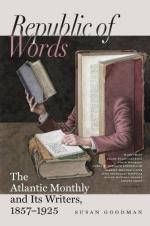The quartz which composes these interposed sheets, thus separated, yet combined, is crystallized throughout, and highly mineralized,—belonging, in fact, to the first class of quartz lodes recognized in all the general descriptions of the veins of this region. The associated minerals are, here, cuprite or yellow copper, green malachite or carbonate of copper, mispickel or arsenical pyrites, zinc blende, sesquioxyde of iron, rich in gold, and also frequent “sights” or visible masses of gold itself. The gold is also often visible to the naked eye in all the associated minerals, and particularly in the mispickel and blende.
The main quartz vein of this interesting lead varies from three to ten inches in thickness at different points on the surface-level, but is reported as increasing to twenty inches thick at the bottom of the shaft, already carried down to a depth of forty feet. This very considerable variation in thickness will be found to be owing to the folds or plications of the vein, to which we shall hereafter make more particular allusion.
The minerals associated with the quartz in this vein, especially the cuprite and mispickel, are found most abundantly upon the foot-wall side, or underside of the quartz itself. The smaller accompanying vein before alluded to appears to be but a repetition of the larger one in all its essential characteristics, and is believed by the scientific examiners to be fully as well charged with gold. That this is likely to come up to a very remarkable standard of productiveness, perhaps more so than any known vein in the world, is to be inferred from the official statement in the “Royal Gazette” of Wednesday, January 20, 1864, published by authority, at the Chief Gold-Commissioner’s office in Halifax, in which the average yield of the Montague vein for the month of October, 1863, is given as 3 oz. 3 dwt. 4 gr., for November as 3 oz. 10 dwt. 13 gr., and for December as 5 oz. 9 dwt. 8 gr., to the ton of quartz crushed during those months respectively. Nor is the quartz of this vein the only trustworthy source of yield. The underlying slate is filled with bunches of mispickel, not distributed in a sheet, or in any particular order, so far as yet observed, but developed throughout the slate, and varying in size from that of small nuts to many pounds in weight, masses of over fifty pounds having been frequently taken out. This peculiar mineral has always proved highly auriferous in this locality, and a careful search will rarely fail to detect “sights” of the precious metal imbedded in its folds, or lying hidden between its crystalline plates.




